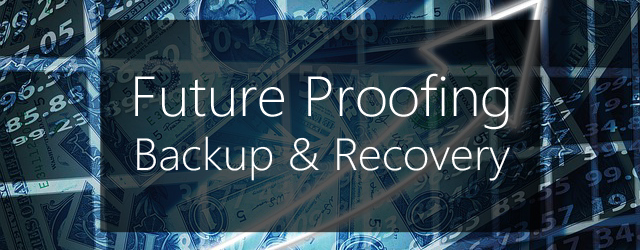Researching, selecting and investing in a backup & recovery solution is no easy thing. It takes time, it takes careful consideration, and it takes money. So really, it should go without saying that this is not a process you want to go through any more frequently than is absolutely necessary. Well, that’s why it’s so important to keep the future in mind when honing your data protection strategy. The last thing you want is to have to do it all over again in 12 months’ time!
In this article, we’re going to take a look into what you need to think about when future-proofing a backup & recovery solution.
Will your backup & recovery solution scale?

In a year’s time, do you expect your business to be in the exact same position it is now? How about in five years? You answered no, of course, because answering yes would be delusional. The purpose of all businesses is to achieve constant, sustainable growth. Well, this means that your IT infrastructure, systems and data will grow too. So what happens if you’ve invested in a backup & recovery solution that’s a perfect fit for your current situation, but can’t keep up with the pace of your expansion? Potentially, you could end up with vulnerable systems and data. .
Your business almost certainly already has projections for growth in other fields – revenue, staff, overheads, etc. The next step, and unfortunately one that many businesses fail to take, is to apply this to the IT department. As a result of growth in the other areas, how much will your data grow as a consequence? How many new systems will this require? What kind of new infrastructure will be needed as a result? And ultimately, how will your backup & recovery strategy scale to protect all of this?
If the BDR strategy you’ve invested in isn’t capable of keeping up, or if doing so will become untenable from a budgetary standpoint, then you’re going to be in trouble.
What’s more, it’s also worth considering that the opposite could be true. While nobody likes to consider it, it’s an unfortunate fact that businesses can shrink in scope too. Future-proofing a BDR strategy doesn’t mean sinking a whole lot of money in something you don’t need right now, in anticipation of future growth that may not eventuate.
Rather, it means ensuring your backup solution addresses your needs at present, but also has the potential to continue addressing your needs in future.
How will this affect your budget?

Following on from the above section, your budget is the next obvious consideration. If your backup & recovery strategy is capable of scaling that’s fantastic, but what will that cost you?
A lot of backup and recovery vendors will charge an arm and a leg the larger your business grows. This can be particularly insidious in the form of vendors who offer free versions for small environments, but then charge at near-enterprise levels for anything above that. When budgeting your BDR strategy, it’s important to take into account not just what the solution is costing you now, but what the potential costs could be as your business grows.
Again, this is also true in reverse: is the huge cost of a solution that you don’t really need now, but may need in future, going to be justified if things take a downward turn in your business?
It’s also worth considering licensing, particularly in regards to virtual environments. If you’re running Hyper-V, for example, how does your prospective solution charge for that? Per guest? Per GB of data? Per socket? These are all pretty common licensing techniques, and they can all quickly become very expensive the larger your business grows.
On the other hand, a solution that licenses per host machine, with unlimited guests and data sizes, could potentially be much more affordable.
Will it support new technologies?

Technology keeps on advancing. If you haven’t worked that out by now, you haven’t been paying attention to the century so far. Now, obviously trying to predict those technology changes is a pretty close to the definition of pointless, because even people who do that for a living tend to get it wrong more often than not. What you can do, however, is a bit of background research into how your prospective backup and recovery solution has handled new technologies in the past. If they were behind the 8-ball then, it could be a reasonable indicator that they will be again the next time something new rolls out.
This can particularly be an issue with freeware or opensource solutions, which often don’t have full-time developers who are able to keep up with technological changes. However the big players aren’t immune either.
A perfect example of this comes in the form of virtualization. Virtualized servers like Hyper-V guests have been replacing physical environments in many workplaces for years. And it’s something that a lot of the larger backup & recovery solutions, who were firmly established for years or even decades in the physical server space, have been frantically playing catch-up on. Many are continuing to lose market-share to other vendors that can and do support virtualized environments much more comprehensively. If these solutions can’t keep up with such a massive shift as virtualization, how will they handle the next big change in technology?
But even something as simple as new versions of Operating Systems like Windows Server are important indicators of how well your prospective BDR solution will keep up with new technologies. How long did it take them to support the most recent version of your chosen OS following its release? Are they likely to do better the next time around?
How does BackupAssist measure up?
Well, we’re sure you don’t want to hear a big, self-aggrandizing plug at this point. But the fact is that BackupAssist is a highly scalable backup & recovery solution. Here’s a 10 second run-down on how we address the points covered above:
Will we scale – Yes. In fact, BackupAssist’s modular licensing makes us ideal for scaling up in future. Rather than having to invest a significant amount upfront for features you don’t need, you can just purchase the base-license of BackupAssist for a fraction of the cost. Then, as your needs grow in future, simply purchase our low-cost Add-ons to add the features your require. What’s more, BackupAssist is particularly scalable for Hyper-V environments, as our software is licensed per host. This means you can continue adding guests without needing to buy more licenses, or you can add additional hosts without needing to pay for all the new guests they will carry.
Will we hurt your budget – No! BackupAssist is one of the most cost-effective third-party solutions on the market. Scaling up is not only easy, it’s highly affordable. Check out our pricing info here – enough said!
Do we keep up with technology – Yes. BackupAssist has a dedicated team of developers who ensure we are fully supportive of any and all new technologies our customers need. A prime example of this was Windows Server 2012 and 2012 R2, which we were one of the very first backup & recovery solutions in the world to fully support.
What factors do you take into account when future-proofing?
Leave a comment below, tweet @BackupAssist or post to Facebook.
Share this article, for a future of safer data.
